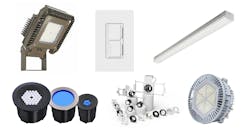North American commercial rooftops encompass more than 42 billion square feet, according to recent figures from the Energy Information Administration, Washington, D.C. Although perceived by some as a waste of space, Solyndra — a fairly recent entrant into the solar photovoltaic (PV) system design and manufacturing arena — intends to cultivate part of this unused ocean of real estate into a hot commodity — literally.
Solyndra's initial offering consists of a solar PV system that “follows the sun.” Introduced this past October, the product is the creation of Chris Gronet, founder and CEO of the Fremont, Calif.-based company, which employs a workforce of more than 500 and operates a 300,000-square-foot manufacturing complex.
“With a traditional U.S. PV system, solar panels must be tilted 20 degrees and situated facing south,” says Kelly Truman, Solyndra's vice president of sales, marketing, and business development. “Chris's idea was to develop a product that could optimize the generation of electricity from any angle and direction.”
Specifically designed for large, low-slope commercial rooftops, these copper indium gallium selenide (CIGS)-based thin-film solar panels incorporate proprietary cylindrical tubes that the company says capture sunlight across a 360-degree photovoltaic surface.
“In addition to passively tracking direct sunlight, the product's tubular shape allows the system to collect diffused light from all angles,” says Truman. “And since active thin-film material is used on the bottom of the cylinders, whatever light reflects off the roof also is collected for energy use.”
Each solar PV panel is comprised of 40 tubes attached to a 3½-foot by 6-foot frame held horizontally by 10-inch-high mounts. Within every tube, more than 140 cylindrical CIGS cells capture sunlight. Because the panels are positioned “like a coffee table,” as Truman notes, they can be packed closely together — thereby covering a larger area and converting more sunlight into energy compared to conventional solar PV systems, which require panels to be placed far enough apart to avoid “shadowing.”
Another distinctive product feature is spacing between each of the cylindrical tubes that allows air to flow freely through the solar panels. Tested and certified for use in wind speeds up to 130 mph, the company says this self-ballasting system negates the need for weighty anchoring hardware and/or invasive drilling into rooftops.
“This PV system does not require rooftop penetrations or ballasts to withstand wind loads,” says Andrea Zepf of Phoenix Solar, an international photovoltaic systems integrator headquartered in Sulzemoos, Germany, that will begin installing Solyndra's PV system for clients in 2009. “Up to now, due to static reasons, a lot of commercial roofs could not be covered with PV systems that require ballasts to withstand wind loads.”
Truman says this absence of extensive mounting hardware means the Solyndra panels can be installed in about one-third the time it takes assemble a conventional solar PV system.
“In turn, this translates into the installation cost being cut approximately in half, because much of the labor and hardware costs are eliminated,” he adds. “For contractors, the mechanical assembly is fast and straightforward, so they can quickly move on to the electrical portion of the project.”
According to Zepf, testing performed by Phoenix Solar shows the Solyndra panel's energy yield is competitive with that produced by conventional modules mounted at a 30-degree angle. With a distributed load of 3.3 pounds per square foot, the system can be used on rooftops that would otherwise require structural reinforcement to harvest solar power. In addition, its lighter weight allows the system to be disassembled for roof maintenance or for use elsewhere.
One of the product design challenges that had to be overcome was the problem of moisture penetration.
“Moisture can corrode CIGS material easily,” Truman explains. “Therefore, we had to find a way to make sure the CIGS material was sealed from outside moisture, which led to our tube-within-a-tube design that features hermetic (glass-to-metal) seals at the ends of each module.
UL 1703- and IEC 61730/61646-certified, the system carries a 25-year warranty. For more information on Solyndra's solar PV panels, visit www.solyndra.com.



